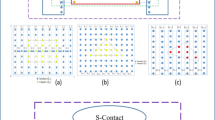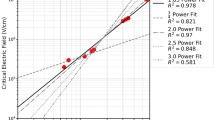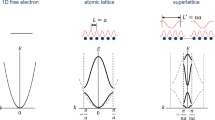Abstract
In order to interpret the electrical characteristics of fabricated Au/ZnO/n-Si structures as a function of frequency and voltage well, their capacitance–voltage (C–V) and conductance–voltage (G/ω–V) measurements were carried out in a wide range of frequencies (0.7 kHz–2 MHz) and voltages (± 6 V) by 50 mV steps at room temperature. Both the C–V and G/ω–V plots have reverse, depletion, and accumulation regions such as a metal–insulator/oxide semiconductor (MIS or MOS) structures. The values of doped-donor atoms (N D), Fermi energy level (E F), barrier height (ΦB), and series resistance (R s) of the structure were obtained as a function of frequency and voltage. While the value of N D decreases with increasing frequency almost as exponentially, the value of depletion width (W D) increases. The values of C and G/ω increase with decreasing frequency because the surface states (N ss) are able to follow the alternating current (AC) signal, resulting in excess capacitance (C ex) and conductance (G ex/ω), which depends on their relaxation time and the frequency of the AC signal. The voltage-dependent profiles of N ss were obtained from both the high–low frequency capacitance and Hill-Colleman methods. The other important parameter R s of the structure was also obtained from the Nicollian and Brews methods as a function of voltage.
Similar content being viewed by others
References
G. Ersöz, I. Yücedag, Y. Azizian-Kalandaragh, I. Orak, and S. Altındal, IEEE Trans. Electron Dev. 63, 2948 (2016).
S. Demirezen, A. Kaya, Ö. Vural, and Ş. Altındal, Mater. Sci. Semicond. Process. 33, 140 (2015).
Y.Ş. Asar, T. Asar, Ş. Altındal, and S. Özçelik, Phil. Mag. 95, 2885 (2015).
S.A. Yerişkin, M. Balbasi, and A. Tataroglu, J. Appl. Poly. Sci. 133 (2016). doi:10.1002/app.43827
M.M. Bulbul, S. Altindal, F. Parlakturk, and A. Tataroglu, Surf. Interface. Anal., 43, 1561 (2011).
H. Tecimer, H. Uslu, Z.A. Alahmed, F. Yakuphanoğlu, and Ş. Altındal, Compos. Part B: Eng. 57, 25 (2014).
Y.S. Altindal, H.I. Unal, and S. Bekir, J. Appl. Poly. Sci. 120, 390 (2011).
İ. Taşçıoğlu, M. Soylu, ş. Altındal, A.A. Al-Ghamdi, and F. Yakuphanoglu, J. Alloys Compd. 541, 462 (2012).
M.K. Hudait and S.B. Krupanidhi, Solid-State Electron 44, 1089 (2000).
M. Afsal, C. Wang, L. Chu, H. Ouyang, and L. Chen, J. Mater. Chem. 22, 8420 (2012).
A. Singh, Solid State Electron. 28, 223 (1985).
M.M. Bülbül, S. Zeyrek, Ş. Altındal, and H. Yüzer, Microelectron. Eng. 83, 577 (2006).
P. Cova and A. Singh, J. Appl. Phys. 82, 5217 (1997).
D. Sands, K.M. Brunson, and M.H. Najaran, Semicond. Sci. Technol. 7, 1091 (1992).
J. Osvald and E. Burıan, Solid- State Electronics 42, 191 (1998).
S. Bengi and M.M. Bülbül, Cur Appl. Phys. 13, 1819 (2013).
E.H. Nicollian, Mos (Metal Oxide Semiconductor) Physics and Technology (New York: Wiley- Interscience, 2002).
M. Depas, R.L. Van Meirhaeghe, W.H. Laflere, and F. Cardon, Semicond. Sci. Technol. 7, 1476 (1992).
S. Ashok, J.M. Borrego, and R.J. Gutmann, Solid State Electron. 22, 621 (1979).
W. Divigalpitiya, Sol. Energy Mater. 18, 253 (1989).
H.M. Xiong, Y. Xu, O.G. Ren, and Y.Y. Xia, J. Am. Chem. Soc. 130, 7522 (2008).
Z.K. Tang, G.K.L. Wong, P. Yu, M. Kawasaki, A. Ohtomo, H. Koinuma, and Y. Segawa, Appl. Phys. Lett. 72, 3270 (1998).
Z.L. Wang, X.Y. Kong, Y. Ding, P.X. Gao, W.L. Hughes, R.S. Yang, and Y. Zhang, Adv. Function. Mater. 14, 943 (2004).
J.C. Johnson, H.Q. Yan, P.D. Yang, and R.J. Saykally, J. Phys. Chem. B 107, 8816 (2003).
X.D. Wang, C.J. Summers, and Z.L. Wang, Nano Lett. 4, 423 (2004).
S. Bilge Ocak, A.B. Selçuk, G. Aras, and E. Orhan, Mater. Sci. Semicond. Process. 38, 249 (2015).
E.H. Nicollian and J.R. Brews, Solid-State Electron. 27, 953 (1984).
S.A. Yeriskin, H. Ibrahim Unal, and B. Sari, J. Appl. Poly. Sci. 120, 390 (2011).
I.M. Afandiyeva, I. Dökme, Ş. Altındal, M.M. Bülbül, and A. Tataroğlu, Microelectron. Eng. 85, 247 (2008).
A. Kaya, S. Alialy, S. Demirezen, M. Balbaşı, S.A. Yerişkin, and A. Aytimur, Ceram. Inter. 42, 3322 (2016).
E. Arslan, S. Bütün, Y. Safak, and E. Özbay, J. Electron. Mater. 39, 2681 (2010).
P.S. Ho, E.S. Yang, H.L. Evans, and X. Wu, Phys. Rev. Lett. 60, 177 (1986).
J. Werner, A.F.J. Levi, R.T. Tung, M. Anzlowar, and M. Pinto, Phys. Rev. Lett. 60, 53 (1988).
P. Chattopadhyay and B. Raychaudhuri, Solid State Electron. 1992, 35 (1992).
W.A. Hill and C.C. Coleman, Solid State Electron. 23, 915 (1980).
M. Sharma and S.K. Tripathi, Mater. Sci. Semicond. Process. 41, 155 (2016).
N. Shiwakoti, A. Bobby, K. Asokan, and B. Antony, Mater. Sci. Semicond. Process. 42, 378 (2016).
H.G. Çetinkaya, S. Alialy, Ş. Altındal, A. Kaya, and İ. Uslu, J. Mater. Sci.: Mater. Electron. 26, 3186 (2015).
M. Asghar, K. Mahmood, F. Malik, and M.A. Hasan, 6th vacuum and surface sciences conference of Asia and Australia (VASSCAA-6). J. Phys. Conf. Ser. 439, 012031 (2013).
R. Singh, P. Sharma, Md A. Khan, V. Garg, V. Awasthi, A. Kranti, S. Mukherjee, J. Phys. D: Appl. Phys. 49, 445305 (2016).
L. Rajan, IEEE Trans. Nanotechnol. 15, 201 (2016).
Acknowledgement
ARTEMIZ Research and Development (R&D) Company supported this work. ARTEMIZ is an establishment, which is financially supported by Small and Medium Enterprises Development Organization (KOSGEB), Republic of Turkey.
Author information
Authors and Affiliations
Corresponding author
Rights and permissions
About this article
Cite this article
Nikravan, A., Badali, Y., Altındal, Ş. et al. On the Frequency and Voltage-Dependent Profiles of the Surface States and Series Resistance of Au/ZnO/n-Si Structures in a Wide Range of Frequency and Voltage. J. Electron. Mater. 46, 5728–5736 (2017). https://doi.org/10.1007/s11664-017-5613-7
Received:
Accepted:
Published:
Issue Date:
DOI: https://doi.org/10.1007/s11664-017-5613-7




